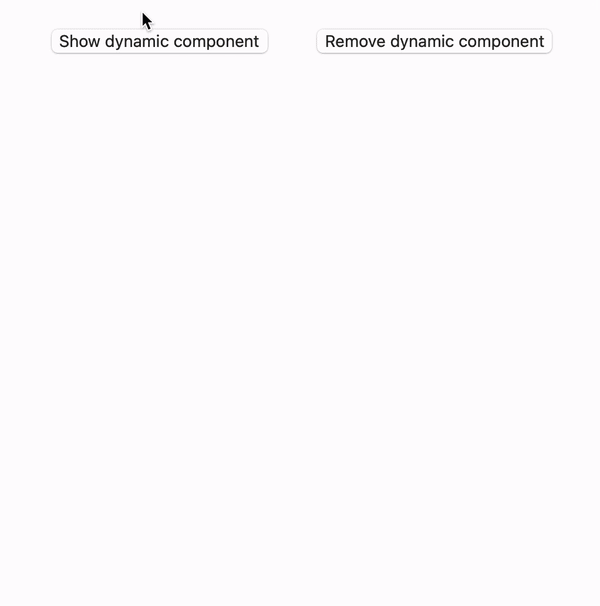Бывают ситуации, когда компонент необходимо добавить на страницу динамически. Например, тултип или баннер. В такие моменты на помощь приходит Angular, который умеет создавать компоненты в рантайме и рендерить их. Для этого разработчик может воспользоваться методом createComponent у ViewContainerRef.
Но с 13 версией фреймворка API этого метода немного изменился. В этой статье поделюсь тем, как теперь выглядит процесс динамического добавления компонента.
Прежде чем разобраться в этом, хочу поздравить с окончательным переездом фреймворка на Ivy, новый движок рендеринга Angular. Наконец-то мы окончательно попрощались с View Engine, и теперь Ivy покажет себя в полной мере!
Возвращаясь к динамическим компонентам: предположим, нам нужно динамически отрисовать DynamicComponent, который для простоты выглядит следующим образом:
dynamic.component.ts
import {Component} from '@angular/core';
@Component({
selector: 'app-dynamic',
template: `
<div><img
src='https://images.pexels.com/photos/7294069/pexels-photo-7294069.jpeg?auto=compress&cs=tinysrgb&h=750&w=350'
alt='image'>
</div>`,
styles: [`
:host {
text-align: center;
}`
]
})
export class DynamicComponent {
}
Этот компонент будем отображать в AppComponent при клике на «show-btn» и удалять по кнопке «remove-btn» и добавим для них обработчики: showDynamicComponent и removeDynamicComponent соответственно.
app.component.html
<div class="buttons-container">
<button class="show-btn" (click)="showDynamicComponent()">Show component</button>
<button class="remove-btn" (click)="removeDynamicComponent()">
Remove component
</button>
</div>
<ng-template #dynamic></ng-template>Обратите внимание на <ng-template #dynamic></ng-template> — это контейнер для DynamicComponent. Именно здесь будет отображаться наш динамический компонент.
Дальше и начинается самое главное — как работать с таким компонентом:
Как было до Angular 13
1) С шаблоном мы закончили, теперь займемся функционалом добавления и удаления компонента. Сперва напишем обработчик showDynamicComponent.
app.component.ts
import {
Component,
ComponentFactoryResolver,
ComponentRef,
OnDestroy,
ViewChild,
ViewContainerRef,
} from '@angular/core';
import { DynamicComponent } from './dynamic.component';
@Component({
selector: 'my-app',
templateUrl: './app.component.html',
styleUrls: ['./app.component.css'],
})
export class AppComponent implements OnDestroy {
@ViewChild('dynamic', { read: ViewContainerRef })
private viewRef: ViewContainerRef;
private componentRef: ComponentRef<DynamicComponent>;
constructor(
private readonly componentFactoryResolver: ComponentFactoryResolver
) {}
showDynamicComponent(): void {
this.viewRef.clear(); // destroys all views in container
const componentFactory =
this.componentFactoryResolver.resolveComponentFactory(DynamicComponent);
this.componentRef = this.viewRef.createComponent(componentFactory);
}
}Что за componentFactory? Это фабрика нашего динамического компонента, полученная с помощью ComponentFactoryResolver.
А ComponentFactoryResolver в свою очередь является хранилищем, которое по ключу DynamicComponent найдет и вернет фабрику, содержащую все необходимое для создания экземпляра DynamicComponent.
На 30 строке создаем ссылку на наш динамический компонент — this.componentRef. Получаем ее с помощью передачи фабрики DynamicComponent в метод createComponent у this.viewRef (ссылка на контейнер динамического компонента).
Сигнатура этого метода:
abstract createComponent<C>(
componentFactory: ComponentFactory<C>,
index?: number,
injector?: Injector,
projectableNodes?: any[][],
ngModuleRef?: NgModuleRef<any>
): ComponentRef<C>Помимо фабрики компонента, мы также можем передать опциональные параметры, подробней в документации.
2) После того, как мы закончили с добавлением компонента, можно приступить к его удалению: добавляем обработчик removeDynamicComponent для кнопки «remove-btn».
app.component.ts:
import {
Component,
ComponentFactoryResolver,
ComponentRef,
ViewChild,
ViewContainerRef,
} from '@angular/core';
import { DynamicComponent } from './dynamic.component';
@Component({
selector: 'my-app',
templateUrl: './app.component.html',
styleUrls: ['./app.component.css'],
})
export class AppComponent {
@ViewChild('dynamic', { read: ViewContainerRef })
private viewRef: ViewContainerRef;
private componentRef: ComponentRef<DynamicComponent>;
constructor(
private readonly componentFactoryResolver: ComponentFactoryResolver
) {}
showDynamicComponent(): void {
this.viewRef.clear(); // destroys all views in container
const componentFactory =
this.componentFactoryResolver.resolveComponentFactory(DynamicComponent);
this.componentRef = this.viewRef.createComponent(componentFactory);
}
removeDynamicComponent(): void {
this.viewRef.clear(); // destroys all views in container
}
}
Здесь мы просто очищаем наш view-контейнер от всех представлений, и DynamicComponent перестанет отображаться.
Полный код app.component.ts
import {
Component,
ComponentFactoryResolver,
ComponentRef,
ViewChild,
ViewContainerRef,
} from '@angular/core';
import { DynamicComponent } from './dynamic.component';
@Component({
selector: 'my-app',
templateUrl: './app.component.html',
styleUrls: ['./app.component.css'],
})
export class AppComponent {
@ViewChild('dynamic', { read: ViewContainerRef })
private viewRef: ViewContainerRef;
private componentRef: ComponentRef<DynamicComponent>;
constructor(
private readonly componentFactoryResolver: ComponentFactoryResolver
) {}
showDynamicComponent(): void {
this.viewRef.clear();
const componentFactory =
this.componentFactoryResolver.resolveComponentFactory(DynamicComponent);
this.componentRef = this.viewRef.createComponent(componentFactory);
}
removeDynamicComponent(): void {
this.viewRef.clear();
}
}Теперь запустим наш код:

Все работает, идем дальше :)
Что изменилось в 13 версии Angular
В этой версии упростилось API для создания динамического компонента (нам больше не нужно заботиться о его фабрике), а в 13.2 версии классы ComponentFactory и ComponentFactoryResolver устарели.
Посмотрим на новую сигнатуру метода:
abstract createComponent<C>(
componentType: Type<C>,
options?: {
index?: number;
injector?: Injector;
ngModuleRef?: NgModuleRef<unknown>;
projectableNodes?: Node[][]; }
): ComponentRef<C>Теперь нам достаточно просто передать тип компонента DynamicComponent в метод createComponent, а с фабрикой Angular сам разберется.
Добавим изменения в обработчик showDynamicComponent:
app.component.ts
import { Component, ViewChild, ViewContainerRef } from '@angular/core';
import { DynamicComponent } from './dynamic.component';
@Component({
selector: 'my-app',
templateUrl: './app.component.html',
styleUrls: ['./app.component.css'],
})
export class AppComponent {
@ViewChild('dynamic', { read: ViewContainerRef })
private viewRef: ViewContainerRef;
private componentRef: ComponentRef<DynamicComponent>;
showDynamicComponent(): void {
this.viewRef.clear();
this.componentRef = this.viewRef.createComponent(DynamicComponent); // теперь так
}
removeDynamicComponent(): void {
this.viewRef.clear();
}
}Стоит уточнить, что хоть сигнатура метода createComponent изменилась, мы все также можем дополнительно передать index, injector, ngModuleRef и projectableNodes, но уже отдельным опциональным объектом.
А за счет того, что createComponent все так же возвращает ComponentRef, нам практически не нужно менять код при переходе на новую версию фреймворка.
Вывод
Теперь мы узнали, как создавать динамический компонент в 13 версии Angular и рассмотрели отличия от предыдущей версии фреймворка.
Создавать динамический компонент стало проще:
не нужно беспокоиться о создании фабрики
не нужно инжектировать вспомогательные зависимости
схожая сигнатура метода создания компонента не требует значительного изменения кода
Angular становится лучше и лучше :)
Было (Angular <= 12):
export class AppComponent implements {
@ViewChild('dynamic', { read: ViewContainerRef })
private viewRef: ViewContainerRef;
private componentRef: ComponentRef<DynamicComponent>;
constructor(
private readonly componentFactoryResolver: ComponentFactoryResolver
) {}
showDynamicComponent(): void {
this.viewRef.clear();
const componentFactory =
this.componentFactoryResolver.resolveComponentFactory(DynamicComponent);
this.componentRef = this.viewRef.createComponent(componentFactory);
}
removeDynamicComponent(): void {
this.viewRef.clear();
}
}Стало (Angular 13):
export class AppComponent {
@ViewChild('dynamic', { read: ViewContainerRef })
private viewRef: ViewContainerRef;
showDynamicComponent(): void {
this.viewRef.clear();
this.viewRef.createComponent(DynamicComponent);
}
removeDynamicComponent(): void {
this.viewRef.clear();
}
}Ссылка на старый код.
Ссылка на новый код.
Полезные ссылки


RCnowak
Можно ли прикрепить директиву к динамически созданному компоненту?
MiliyKot Автор
Помнится, что с этим есть сложности...
И фича, которая помогла бы в этом, сейчас в roadmap ангуляра -> future
Можно почитать здесь:
https://angular.io/guide/roadmap#support-adding-directives-to-host-elements
https://github.com/angular/angular/issues/8785
Как вариант, создавать директиву в самом динамическом компоненте, например,
https://stackoverflow.com/questions/41298168/how-to-dynamically-add-a-directive
Или добавить обертку в дин. компоненте и там указать нужную директиву
Либо совсем упороться и сделать что-то подобное :D
https://stackblitz.com/edit/angular-mcbbub-eyraon (даже не стоит воспринимать всерьез)